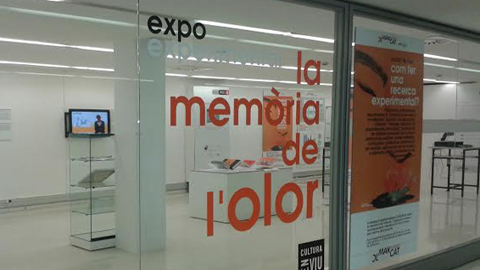"The Memory of Smell", a research turned into exhibition

The research conducted by the UAB and the Hospital Clínic focusing on olfactory memory will be on display as an exhibition entitled "La memòria de l'olor" until 20 June in the hallway of the Communication Library and General Newspaper Archives, with explanations of the methodology used and some of the results.
21/05/2014
"Fragrances forms part of a corporate identity and they must be given legal protection", affirms lecturer Pere Navalles, co-director of the research and expert in smells.
"La memòria de l'olor" [The Memory of Smell] will be on display at the Communications Library and General Newspaper Archives until 20 June. The exhibition shows the process, methodology and first resutls of the scientific research "OLMARCAT", which was conducted with the aim of discovering the ability to recall and have memories of smells. No other research in Catalonia had been conducted previously to study this subject.
This research, whose main researchers are Pere Navalles, lecturer of the Department of Advertising, Public Relations and Audiovisual Communication at the UAB, and Joaquim Mullol, doctor at the Hospital Clínic, consisted in analysing the answers of 4,1000 citizens of Catalonia with a survey on aromas and memories.
In June 2012, 50,000 questionnaires containing 4 envelopes with different smells inside, were sent out with the La Vanguardia newspaper. Of these, 4,100 questionnaries were answered, which then were analysed by the UAB Statistics Service. Previously, in September 2011, a pilot programme was conducted with 300 UAB students. Lecturer Pere Navalles, whose PhD thesis focused on the memory of smells, has spent years researching the world of smells and is one of its forefathers.
The questionnaire, apart from identifying smells, asked participants to recognise the product and brand. The smells were kept in single-dose packaging and the products were chocolate (Cola Cao), tomato (Ketchup), coffee (Nescafè), and white smell (sugar). The questionnaire formed part of the exhibition which can now be seen at the General Newspaper Archives, as well as other aromas which visitors will be able to smell and questionnaires they can fill out.
SOME RESEARCH CONCLUSIONS
Once the responses were analysed, some of the conclusions reached by the research were that women have greater olfactory capacities while men have greater olfactory memory, which are two different concepts. Researchers also detected that there is reduction in capacity according to age (-6.20%), but the loss of olfactory memory is greater the older a person ages (-17.73%).
"The research shows that fragrances form a part of a corporate identity and they must be given legal protection since they are elements that differentiate a brand", highlights Pere Navalles, lecturer and co-director of the research who has spent the past seven years researching this subject.
Doctor Joaquim Mullol from the Hospital Clínic and also co-director of the study, assures that "olfactory memory is one of the most important traits of the sense of smell structured within the primitive brain and allows us to connect smells with memories and emotions".
At these moments, a scientific paper is being prepared and will be ready to publish in one or two years, given the large amount of data needed to be analysed.
Participating in the research were the Barcelona City Council, the Volkswagen Group, the Institute for Diagnostic Imaging (IDI) of the Vall d'Hebron Hospital, Inever, Lucta, Sampling Innovations, UAB Statistics Service, and the Network of County Archives (XAC).